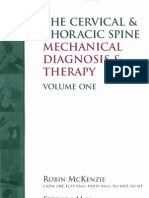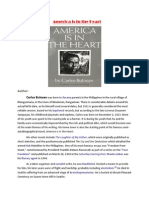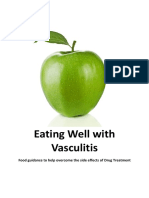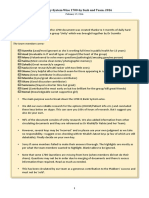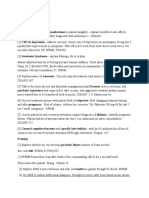Case - Study - A - Questions (1) 2
Case - Study - A - Questions (1) 2
Uploaded by
ReaganCopyright:
Available Formats
Case - Study - A - Questions (1) 2
Case - Study - A - Questions (1) 2
Uploaded by
ReaganOriginal Title
Copyright
Available Formats
Share this document
Did you find this document useful?
Is this content inappropriate?
Copyright:
Available Formats
Case - Study - A - Questions (1) 2
Case - Study - A - Questions (1) 2
Uploaded by
ReaganCopyright:
Available Formats
4-1
Questions for Medical Nutrition Therapy: A Case Study Approach 5th ed.
Case Study A (Case study 4 in text)– Hypertension and Cardiovascular Disease
Instructions: Answer the questions below. You may print your answers or e-mail them to
your instructor.
Note: Your assignment will be checked for originality via the SafeAssign plagiarism tool.
1. Define arterial blood pressure (BP) and explain how it is measured.
-is the pressure exerted by circulating blood upon the walls of blood vessels. It is measured
by using a sphygmomanometer on the upper part of the arm, measuring the systolic and
diastolic pressures.
2. Discuss briefly the mechanisms that regulate arterial blood pressure including the
sympathetic nervous system, the renin-angiotensin-aldosterone system (RAAS), and
renal function?
Arterial pressure is determined partially by cardiac output, which is a function of heart rate
and stroke volume. Heart rate is determinate on the balance between the parasympathetic and
sympathetic nervous systems. The parasympathetic system decreases heart rate, while the
sympathetic system increases heart rate. The sympathetic fibers stimulate the SA node and
ventricles, which in turn release norepinephrine to increase heart rate, increasing blood pressure.
Sympathetic activity also causes vasoconstriction and increased resistance of blood flow,
increasing blood pressure
The renin-angiotensin-aldosterone system (RAAS) regulates the balance of fluids and
electrolytes which effects blood volume, which effect venous return, stroke volume, and cardiac
output. This is a main component of arterial blood pressure. A hormone renin is released from the
kidney to stimulate conversion to Angiotensin I, which eventually gets converted to Angiotensin
II. Increased levels of this will stimulate Aldosterone production, causing kidneys to retain
sodium, increasing blood volume, which in turn increases blood pressure. Angiotensin II also
stimulates vasoconstriction, additionally causing an increase in blood pressure
The kidney is responsible for fluid and electrolyte balance, so if renal function is low,
changes in blood volume will occur, affecting cardiac output, and in turn, lowering or raising
blood pressure.
3. What causes essential hypertension? What is the etiology?
- Obesity, alcohol intake, age, stress, sedentary lifestyles, poor diet, genetics
4. What are the common symptoms of essential hypertension?
- in most cases there will be no apparent symptoms of essential hypertension, But some may
have headaches, dizziness, blurred vision, heartbeat sounds louder
5. Using the JNC 8 guidelines, how is the diagnosis of hypertension made? What blood
pressure readings are used to identify normal BP, stage 1 hypertension, and stage 2
hypertension?
-When bp consistently measures 130/80mmhg
4-2
-Normal is 120/80 mmhg Stage 1 Hypertension: systolic pressure 130-139 mmhg Diastolic
80-90
mmhg, Stage 2 Hypertension: systolic 140 mmhg or higher diastolic 90 mmhg or higher
6. List the risk factors for developing hypertension. What risk factors does Mrs. Moore
currently have? Discuss the contribution of ethnicity to hypertension, especially for
African Americans
-Family history, age, gender, race, Chronic kidney disease
-Mrs. Moore has her race, age, smoking, gender
-High rates of high blood pressure in African-Americans may be due to the genetic make-up
of people of African descent or even the environment.
7. What are the four major modes of treatment for hypertension?
-ACE inhibitors, Channel blockers, beta blockers and anti hypertension medications
8. Dr. Evans indicated in his note that he will “rule out metabolic syndrome.” What is
metabolic syndrome?
- Is a cluster of conditions that occur together increasing heart disease, stroke and type 2
diabetes.
9. What factors found in the medical and social history are pertinent for determining Mrs.
Moore's coronary heart disease (CHD) risk category?
-Smoking, being post menopausal, high BP and Stress
10. How is hypertension related to other cardiovascular disorders? What are the possible
complications of uncontrolled or untreated hypertension?
-Hypertension is the most prevalent contributory cause of cardiovascular diseases and deaths.
Chronic hypertension and when the hypertension goes uncontrolled, many adverse diseases
arise. Individuals can have coronary artery disease, left ventricular hypertrophy, cardiac
failure, cardiac enlargement, myocardial infarction, cerebrovascular accident, aneurysm,
impaired renal function, retinal exudates and hemorrhages, and papilledema
11. Briefly describe the DASH eating plan and discuss the major nutrients that are
components of this nutrition therapy.
- Is a flexible and balanced eating plan that helps create a heart-healthy eating style for life.
- Eating veggies, fruits and whole grains
12. Using the 2015 Dietary Guidelines, describe why decreased sodium intake is targeted
as a focus to improve the health of Americans.
- A salt intake of less than 5 grams per day helps to reduce blood pressure and risk of
cardiovascular disease, stroke and heart attack, can also help in reducing high BP
13. What do the current literature and the Evidence Analysis Library (EAL) indicate
regarding the role of sodium intake in the control of hypertension? Is there a
significant correlation between sodium intake and cardiovascular risk?
-Reduction of dietary sodium recommended levels lowers systolic blood pressure by
approximately 2-8mmHg
14. What is the Mediterranean diet? How might this dietary approach be appropriate for
Mrs. Moore? Would this be culturally appropriate for her?
© 2014 Cengage Learning. All Rights Reserved. May not be copied, scanned, or duplicated, in whole or in part, except for use as permitted in a
license distributed with a certain product or service or otherwise on a password-protected website for classroom use.
4-3
-The Mediterranean diet blends the basics of healthy eating with the traditional flavors and
cooking methods of the Mediterranean. High in veggies, fruits, whole grains, beans, nuts, and
seeds.
-This diet might be the correct approach for her due to the fact it is the heart protector and helps
reduce the risk for heart disease, and stroke.
15. Lifestyle modifications reduce blood pressure, enhance the efficacy of antihypertensive
medications, and decrease cardiovascular risk. List lifestyle modifications that have
been shown to lower blood pressure.
-exercise regularly, eat a healthy diet, reduce sodium intake, limit alcohol intake, cut back on
sugars, and stop smoking.
16. What are the health implications of Mrs. Moore’s body mass index (BMI)?
-The health implications of her BMI is unhealthy, she falls in the overweight range, where
she sits at a high risk for hypertension along with cardiovascular disease and diabetes
17. Calculate Mrs. Moore’s energy and protein requirements.
Energy Requirements:
REE for females = 655.1 + 9.6W(weight in kg) + 1.9H (height in centimeters) - 4.7(Age)
160 lbs ÷ 2.2 = 72.73 kg
66 inches x 2.54 cm = 167.64 cm
REE for Mrs. Moore = 655.1 + 9.6(72.73) + 1.9(167.64) – 4.7(57) =
REE for Mrs. Moore = 655.1 + 698.208 + 318.516 – 267.9 = 1403.924 cals
Using Estimated Energy Requirements for Normal Individual
Lower Limit EER for Mrs. Moore = 25 x 72.73 = 1818.25
Upper Limit EER for Mrs. Moore = 30 x 72.73 = 2181.9
Protein Requirements:
0.8g x 72.73 kg = 58.184 g of protein a day
18. Identify the major sources of sodium and saturated fat in Mrs. Moore's diet. Compare
her typical diet to the components of the DASH diet.
-Mrs. Moore’s diet: DASH
Butter/ margarine: olive oil
Chicken:fish
Donughnuts: fruits
Ranch dressing: Oils
Ice cream:fruits
Sounds: salads, dark geen leafy veggies
Cracker:carrots
Her typical diet includes lots of processed food, whereas she could consuming fresh natural
foods in the DASH diet.
19. What dietary assessment tools that target nutrients known to be associated with
hypertension and CVD risk might be useful in assessing Mrs. Moore's diet?
- Some dietary assessment tools that could be useful include looking at biochemical and
medical tests, such as lipid profiles, albumin levels, electrolytes, and glucose or HgbA1c values.
In Mrs. Moore’s diet, it would be useful to obtain glucose cholesterol, HDL, LDL, triglyceride
levels from lab tests.
4-4
20. Go to http://cvdrisk.nhlbi.nih.gov/. Using this online calculator, determine Mrs.
Moore's risk of CVD based on her lipid profile. Are there other factors that contribute
to her CVD risk?
-Mrs. Moore’s 10-year risk is 15.7%, compared to a 2.2% risk for individuals with optimal risk
factors. Her lifetime risk is 50%, compared to an 8% risk for individuals with optimal risk
factors. Other factors that contribute to her CVD are her diet and exercise level, family
medical history, past tobacco use, and others.
21. When you talk with Mrs. Moore on 3/15, you ask how much weight she would like to
lose. She tells you she would like to weigh 125, which is what she weighed most of her
adult life. Is this reasonable? What would you suggest as a goal for weight loss for Mrs.
Moore? How quickly should Mrs. Moore lose this weight?
-I would suggest a goal of a 5%-10% weight loss in the first six months. This method has
been shown to have the most lasting and consistent effects of maintaining the weight loss, as
well as being the most successful in reducing blood pressure. I would explain this to Mrs.
Moore and help give her some strategies and ideas on how to lose weight in this time frame
22. List your major recommendations for dietary substitutions and/or other changes that
would help Mrs. Moore reach her medical nutrition therapy goals, to be consistent with
the DASH diet and sodium intake guidelines.
-To help Mrs. Moore lose weight in conjunction with the DASH plan, I would recommend that
she increase her fruit and vegetable consumption, especially at breakfast and lunch, and increase
low-fat dairy products. I would also recommend that she use fat-free condiments, less margarine/
butter, eat smaller portions, and limit foods with excessive added sugar.
23. Phillipians 4:6-7 relates to one of the risk factors of hypertension. What is this risk
factor? How does this verse apply?
-The risk factor here is Anxious, which can lead to stress. This verse applies because it says
anytime we feel anxious we are sinning against god, and need to pray and listen to god and his
words.
© 2014 Cengage Learning. All Rights Reserved. May not be copied, scanned, or duplicated, in whole or in part, except for use as permitted in a
license distributed with a certain product or service or otherwise on a password-protected website for classroom use.
4-5
References
Nelms M. Medical Nutrition Therapy A Case Study Approach 5th ed., Cengage
Learning, 2017.
Nelms M. Sucher K, Lacey, K. Nutrition Therapy and Pathophysiology. 3rd ed.
Cengage Learning, 2016.
You might also like
- 8 Week Extream Weight Loss VegDocument36 pages8 Week Extream Weight Loss VegSavannah Agar100% (1)
- The Cervical & Thoracic Spine Mechanical Diagnosis & Therapy - Vol 1Document313 pagesThe Cervical & Thoracic Spine Mechanical Diagnosis & Therapy - Vol 1Eduardo Batista100% (11)
- Module 2: The Scientific Self (Understanding The Self)Document21 pagesModule 2: The Scientific Self (Understanding The Self)Kenneth Sapnu50% (2)
- America Is in The Heart: TitleDocument5 pagesAmerica Is in The Heart: TitleMark Paul Santin GanzalinoNo ratings yet
- Prefixes and Suffixes ListDocument4 pagesPrefixes and Suffixes Listapi-262294171No ratings yet
- Vasculitis DietDocument9 pagesVasculitis DietHemNo ratings yet
- Oral Revalida: EmergenciesDocument74 pagesOral Revalida: EmergenciesCynn AyoNo ratings yet
- OB Final Exam PDFDocument21 pagesOB Final Exam PDFkatiana louis100% (1)
- Blood Pressure Chart in PDFDocument1 pageBlood Pressure Chart in PDFElectraKizzNo ratings yet
- The Chronicle of Neurology + Psychiatry Aug 30 2011Document24 pagesThe Chronicle of Neurology + Psychiatry Aug 30 2011Nino AvantiNo ratings yet
- LetteringPracticeSheets DawnNicoleDesignsDocument19 pagesLetteringPracticeSheets DawnNicoleDesignsCosmina Andreea GogonciaNo ratings yet
- Gastritis PDFDocument6 pagesGastritis PDFsrimardiahkusumaNo ratings yet
- Dialog Medic PacientDocument4 pagesDialog Medic PacientanaNo ratings yet
- Final COVID-19 Survey English ReportDocument19 pagesFinal COVID-19 Survey English ReportPrince YasinNo ratings yet
- Waterbury Diet PDFDocument26 pagesWaterbury Diet PDFrobert allenNo ratings yet
- Naturopathic Case TakingDocument14 pagesNaturopathic Case Takingsohailnoreen5062No ratings yet
- Drug Study CellulitsDocument2 pagesDrug Study CellulitsCzarina CullenNo ratings yet
- Drug Study CholedocholithiasisDocument2 pagesDrug Study CholedocholithiasisCzafranciscoNo ratings yet
- Methylphenidate HydrochlorideDocument2 pagesMethylphenidate Hydrochloridejustforallofyou123No ratings yet
- Sush Corrected-Unity PSYCH 1700 PDFDocument218 pagesSush Corrected-Unity PSYCH 1700 PDFDr-Jahanzaib GondalNo ratings yet
- Il Test Uffi Ciale Di Ammissione A: Medicina in IngleseDocument37 pagesIl Test Uffi Ciale Di Ammissione A: Medicina in IngleseCathy ToyaNo ratings yet
- BarredojuliannenutritionquestionevidenceassignmentDocument5 pagesBarredojuliannenutritionquestionevidenceassignmentapi-639582054No ratings yet
- Nrad Full ReportDocument115 pagesNrad Full ReportSophia RoseNo ratings yet
- Nephrotic Syndrome Adults 508Document6 pagesNephrotic Syndrome Adults 508yuliaevitasariNo ratings yet
- Casc 2022-1Document4 pagesCasc 2022-1BobNo ratings yet
- Laboratory InvestigationDocument4 pagesLaboratory InvestigationsahahhussNo ratings yet
- Closing Movement 3 - Massaging The Dantian - Proofread LN 2021-05-28Document1 pageClosing Movement 3 - Massaging The Dantian - Proofread LN 2021-05-28api-268467409No ratings yet
- The Vegan Eatwell Guide - 2Document2 pagesThe Vegan Eatwell Guide - 2flor.irschoolNo ratings yet
- Effect of Cardiac Rehabilitation On Strength and Balance in Patients After Coronary Artery Bypass GraftDocument5 pagesEffect of Cardiac Rehabilitation On Strength and Balance in Patients After Coronary Artery Bypass GraftJulenda CintarinovaNo ratings yet
- Amlodipine - C20H25ClN2O5 - PubChem PDFDocument72 pagesAmlodipine - C20H25ClN2O5 - PubChem PDFDavid HCNo ratings yet
- Sweet But BalefulDocument2 pagesSweet But Balefulumama mohsinNo ratings yet
- NTC The Pulse TestDocument2 pagesNTC The Pulse TestEvaNo ratings yet
- NUR 115 - LAB ACTIVITY # 1bDocument3 pagesNUR 115 - LAB ACTIVITY # 1bMoira Julianne Serognas BrigoliNo ratings yet
- Mental Toughness and ResilienceDocument1 pageMental Toughness and ResilienceShiv KumarNo ratings yet
- Past Health History Medward3Document1 pagePast Health History Medward3kristel_nicole18yahoNo ratings yet
- CKD ModulDocument31 pagesCKD ModulOlan Adjalah KeknyaNo ratings yet
- Angelica Sinensis - Mmi.2020 CLASS NOTESDocument5 pagesAngelica Sinensis - Mmi.2020 CLASS NOTESJose Andres ArvideNo ratings yet
- NCM 114 Ethical Aspects of Care PromotionDocument2 pagesNCM 114 Ethical Aspects of Care PromotionJane DiazNo ratings yet
- Poster Wsph24b BiomarkersDocument1 pagePoster Wsph24b Biomarkersj4zds2ddsxNo ratings yet
- 526771537Document3 pages526771537Vijay KumarNo ratings yet
- White Paper Experimental Vaccines Covid-19 Feb 23Document35 pagesWhite Paper Experimental Vaccines Covid-19 Feb 23Warren JamesNo ratings yet
- Textbook of Anatomy Upper Limb 1Document1 pageTextbook of Anatomy Upper Limb 1Karpagam S0% (1)
- Intratympanic Steroid TherapyDocument2 pagesIntratympanic Steroid TherapyKai Siang TayNo ratings yet
- Dental Barotrauma in French Military Divers: Results of The POP StudyDocument5 pagesDental Barotrauma in French Military Divers: Results of The POP StudyLiga Odontopediatria RondonienseNo ratings yet
- Introduction To Jamaat e Islah e Muasharah Wa Izala e MunkaratDocument2 pagesIntroduction To Jamaat e Islah e Muasharah Wa Izala e MunkaratmusarhadNo ratings yet
- Quadshot AbstractDocument3 pagesQuadshot AbstractHirak BandyopadhyayNo ratings yet
- Panel Discussion QuestionsDocument2 pagesPanel Discussion QuestionsJoey SanosaNo ratings yet
- All The Notes and More SampleDocument21 pagesAll The Notes and More SampleRichy Segarra0% (1)
- The Vegan Eatwell Guide - 1Document2 pagesThe Vegan Eatwell Guide - 1Nattan N6No ratings yet
- SWORBHPPCPMedical Directive Book 2015Document148 pagesSWORBHPPCPMedical Directive Book 2015richardphilp1640No ratings yet
- Comparative Study of The Mental Health Workplace Policies and Programs Between New Zealand and The PhilippinesDocument11 pagesComparative Study of The Mental Health Workplace Policies and Programs Between New Zealand and The PhilippinesKiana Abella100% (1)
- Keynutients Coloring Book 1 PGDocument32 pagesKeynutients Coloring Book 1 PGNikola GlisicNo ratings yet
- The Eukaryotic Cell Cycle and Cancer: An Overview: About This WorksheetDocument4 pagesThe Eukaryotic Cell Cycle and Cancer: An Overview: About This WorksheetJean Alexander Nazario SotoNo ratings yet
- Ni Putu Diva Iswarani - Env IssuesDocument1 pageNi Putu Diva Iswarani - Env Issuesdiva iswaraniNo ratings yet
- 2.1six Strategies of LearningDocument1 page2.1six Strategies of Learning2cgsyqbc55No ratings yet
- Random Blood Sugar Estimation and Its SignificanceDocument11 pagesRandom Blood Sugar Estimation and Its Significanceapi-38237850% (1)
- Zollienger Ellison Syndrome NotesDocument3 pagesZollienger Ellison Syndrome NotesLamaAlwadieNo ratings yet
- A Study On Traditional Mother Care PlantsDocument6 pagesA Study On Traditional Mother Care PlantsBarnali DuttaNo ratings yet
- Bloomfield, Edgerton - Vedic Variants 02 (Phonetics)Document577 pagesBloomfield, Edgerton - Vedic Variants 02 (Phonetics)the CarvakaNo ratings yet
- REVISED ADULT HEALTH ASSESSMENT FORM (2015) - GuideDocument13 pagesREVISED ADULT HEALTH ASSESSMENT FORM (2015) - GuideBianca MolinaNo ratings yet
- Cami 301-201 Encore Soho Final PosterDocument1 pageCami 301-201 Encore Soho Final PostersandyinlondonNo ratings yet
- Diet Plan For GastritisDocument4 pagesDiet Plan For GastritisNatalia CabezueloNo ratings yet
- CBSE Class 8 Science, Reaching The Age of AdolescenceDocument5 pagesCBSE Class 8 Science, Reaching The Age of AdolescenceR.Shruti 1040-12No ratings yet
- KMKKLDocument7 pagesKMKKLStephany Chavez AlvaNo ratings yet
- اسئلة مفيدة ل المجلس الطبي والهيئةDocument37 pagesاسئلة مفيدة ل المجلس الطبي والهيئةتعلم فالعلم حياةNo ratings yet
- FOCAL DYSTONIA-A NEUROLOGICAL CONDITION-TREATED WITH CAUSTICUM - Karl Robinson MDDocument2 pagesFOCAL DYSTONIA-A NEUROLOGICAL CONDITION-TREATED WITH CAUSTICUM - Karl Robinson MDFaker FockerNo ratings yet
- Diabetes Mellitus Overview LayDocument17 pagesDiabetes Mellitus Overview LaychelitvaleramdNo ratings yet
- Congenital Syphilis - Evaluation, Management, and Prevention - UpToDate PDFDocument18 pagesCongenital Syphilis - Evaluation, Management, and Prevention - UpToDate PDFcuenta personalNo ratings yet
- USANA Technical BulletinDocument2 pagesUSANA Technical BulletinERIK LABASTIDA MEDELLINNo ratings yet
- ICD 10 KulitDocument6 pagesICD 10 KulitManto RossiNo ratings yet
- Entire Infection Control Manual PDFDocument252 pagesEntire Infection Control Manual PDFAbidi HichemNo ratings yet
- Anticholinergic DrugsDocument19 pagesAnticholinergic DrugseashshankarNo ratings yet
- Myco P3 Study QuestionsDocument26 pagesMyco P3 Study QuestionsRosh Hashana Louisse MatbaganNo ratings yet
- Ent SignsDocument10 pagesEnt SignsPrasun Sit SharmaNo ratings yet
- National Mental Health ProgrammeDocument4 pagesNational Mental Health ProgrammeMANISH MAMIDINo ratings yet
- Outcomes Intermediate VocabBuilder Unit15 0Document7 pagesOutcomes Intermediate VocabBuilder Unit15 0Maria BojkivNo ratings yet
- NurseDocument89 pagesNurseMuralidhar Goli100% (1)
- APHASIADocument131 pagesAPHASIArnsharmasNo ratings yet
- African American Vegan Starter GuideDocument40 pagesAfrican American Vegan Starter GuideVegan Future90% (21)
- нструкция импловит.enDocument28 pagesнструкция импловит.enFrère HorNo ratings yet
- Chapter 17 Maxillary Sinus - SlidesDocument40 pagesChapter 17 Maxillary Sinus - SlidesRajat GuptaNo ratings yet
- Chapter 6 Pharmaceutical Policy (PP) 2002 and National Health Policy (NHP) 2002: Discordance in Perspectives and ContentDocument11 pagesChapter 6 Pharmaceutical Policy (PP) 2002 and National Health Policy (NHP) 2002: Discordance in Perspectives and ContentS.Srinivasan ('Chinu'); Renu KhannaNo ratings yet
- Digestive Health & You - 03062018Document8 pagesDigestive Health & You - 03062018Times MediaNo ratings yet
- Ms Ira Singhal Was Born in Meerut To MR Rajendra Singhal and Mrs Anita SinghalDocument2 pagesMs Ira Singhal Was Born in Meerut To MR Rajendra Singhal and Mrs Anita SinghalOutlander.palNo ratings yet
- Communicable Disease & Its PreventionDocument55 pagesCommunicable Disease & Its PreventionArun TamilvananNo ratings yet
- Bhakti Namuna Class Xi Botanical Garden ReportDocument18 pagesBhakti Namuna Class Xi Botanical Garden ReportRIVALS〆toxic100% (2)
- CASE PRESENTATION PP - Anxiety. Tiffany GordonDocument6 pagesCASE PRESENTATION PP - Anxiety. Tiffany GordonTiffany GordonNo ratings yet
- DR - Thomas Acute AbdomenDocument59 pagesDR - Thomas Acute AbdomenIrvan FirmansyahNo ratings yet
- NCP2 ArthritisDocument2 pagesNCP2 Arthritisapi-27015740No ratings yet

